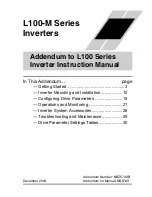
Getting Started
6
Footnotes for the preceding table and the table that follows:
*1: The protection method conforms to JEM 1030.
*2: The applicable motor refers to Hitachi standard 3-phase motor (4-pole). When using other
motors, care must be taken to prevent the rated motor current (50/60 Hz) from exceeding the
rated output current of the inverter.
*3: The output voltage decreases as the main supply voltage decreases (except when using the
AVR function). In any case, the output voltage cannot exceed the input power supply
voltage.
*4: To operate the motor beyond 50/60 Hz, consult the motor manufacturer for the maximum
allowable rotation speed.
*5: The braking torque via capacitive feedback is the average deceleration torque at the shortest
deceleration (stopping from 50/60 Hz as indicated). It is not continuous regenerative braking
torque. The average deceleration torque varies with motor loss. This value decreases when
operating beyond 50 Hz. Note that a braking unit is not included in the inverter. If a large
regenerative torque is required, the optional regenerative braking unit should be used.
*6: The frequency command is the maximum frequency at 9.8V for input voltage 0 to 10 VDC,
or at 19.6 mA for input current 4 to 20 mA. If this characteristic is not satisfactory for your
application, contact your Hitachi sales representative.
*7: If operating the inverter in an ambient temperature of 40–50
°
C, reduce the carrier frequency
to 2.1 kHz, derate the output current by 80%, and remove the top housing cover. Note that
removing the top cover will nullify the NEMA rating for the inverter housing.
*8: The storage temperature refers to the short-term temperature during transport.
*9: Conforms to the test method specified in JIS C0911 (1984). For the model types excluded in
the standard specifications, contact your Hitachi sales representative.
*10:The output voltage of xxxMFU / xxxMFR is 230V.
General Specifications
The following table applies to all L100-M inverters.
Item
General Specifications
Protective housing *1
IP20
Control method
Sine wave pulse-width modulation (PWM) control
Output frequency range *4
0.5 to 360 Hz
Frequency accuracy
Digital command: 0.01% of the maximum frequency
Analog command: 0.1% of the maximum frequency (25
°
C ± 10
°
C)
Frequency setting resolution
Digital: 0.1 Hz; Analog: max. frequency/1000
Volt./Freq. characteristic
V/f optionally variable, V/f control (constant torque, reduced torque)
Overload current rating
150%, 60 seconds
Acceleration/deceleration time
0.1 to 3000 sec., (linear accel/decel), second accel/decel setting
available







































